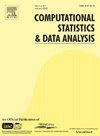Region detection and image clustering via sparse Kronecker product decomposition
IF 1.6
3区 数学
Q3 COMPUTER SCIENCE, INTERDISCIPLINARY APPLICATIONS
引用次数: 0
Abstract
Image clustering is usually conducted by vectorizing image pixels, treating them as independent, and applying classical clustering approaches to the obtained features. However, as image data is often of high-dimensional and contains rich spatial information, such treatment is far from satisfactory. For medical image data, another important characteristic is the region-wise sparseness in signals. That is to say, there are only a few unknown regions in the medical image that differentiate the images associated with different groups of patients, while other regions are uninformative. Accurately detecting these informative regions would not only improve clustering accuracy, more importantly, it would also provide interpretations for the rationale behind them. Motivated by the need to identify significant regions of interest, we propose a general framework named Image Clustering via Sparse Kronecker Product Decomposition (IC-SKPD). This framework aims to simultaneously divide samples into clusters and detect regions that are informative for clustering. Our framework is general in the sense that it provides a unified treatment for matrix and tensor-valued samples. An iterative hard-thresholded singular value decomposition approach is developed to solve this model. Theoretically, the IC-SKPD enjoys guarantees for clustering accuracy and region detection consistency under mild conditions on the minimum signals. Comprehensive simulations along with real data analysis further validate the superior performance of IC-SKPD on clustering and region detection.
基于稀疏Kronecker积分解的区域检测与图像聚类
图像聚类通常是通过对图像像素进行矢量化,将它们视为独立的,然后对得到的特征应用经典聚类方法进行聚类。然而,由于图像数据往往是高维的,并且包含了丰富的空间信息,这样的处理是远远不能令人满意的。对于医学图像数据,另一个重要的特征是信号的区域稀疏性。也就是说,医学图像中只有少数未知区域能够区分与不同患者组相关的图像,而其他区域是无信息的。准确地检测这些信息区域不仅可以提高聚类的准确性,更重要的是,它还可以为它们背后的原理提供解释。由于需要识别感兴趣的重要区域,我们提出了一个通用框架,称为通过稀疏Kronecker积分解(IC-SKPD)的图像聚类。该框架旨在同时将样本划分为簇,并检测用于聚类的信息区域。我们的框架是通用的,因为它提供了对矩阵和张量值样本的统一处理。提出了一种迭代硬阈值奇异值分解方法来求解该模型。理论上,IC-SKPD在最小信号的温和条件下保证了聚类精度和区域检测一致性。综合仿真和实际数据分析进一步验证了IC-SKPD在聚类和区域检测方面的优越性能。
本文章由计算机程序翻译,如有差异,请以英文原文为准。
求助全文
约1分钟内获得全文
求助全文
来源期刊

Computational Statistics & Data Analysis
数学-计算机:跨学科应用
CiteScore
3.70
自引率
5.60%
发文量
167
审稿时长
60 days
期刊介绍:
Computational Statistics and Data Analysis (CSDA), an Official Publication of the network Computational and Methodological Statistics (CMStatistics) and of the International Association for Statistical Computing (IASC), is an international journal dedicated to the dissemination of methodological research and applications in the areas of computational statistics and data analysis. The journal consists of four refereed sections which are divided into the following subject areas:
I) Computational Statistics - Manuscripts dealing with: 1) the explicit impact of computers on statistical methodology (e.g., Bayesian computing, bioinformatics,computer graphics, computer intensive inferential methods, data exploration, data mining, expert systems, heuristics, knowledge based systems, machine learning, neural networks, numerical and optimization methods, parallel computing, statistical databases, statistical systems), and 2) the development, evaluation and validation of statistical software and algorithms. Software and algorithms can be submitted with manuscripts and will be stored together with the online article.
II) Statistical Methodology for Data Analysis - Manuscripts dealing with novel and original data analytical strategies and methodologies applied in biostatistics (design and analytic methods for clinical trials, epidemiological studies, statistical genetics, or genetic/environmental interactions), chemometrics, classification, data exploration, density estimation, design of experiments, environmetrics, education, image analysis, marketing, model free data exploration, pattern recognition, psychometrics, statistical physics, image processing, robust procedures.
[...]
III) Special Applications - [...]
IV) Annals of Statistical Data Science [...]
 求助内容:
求助内容: 应助结果提醒方式:
应助结果提醒方式:


